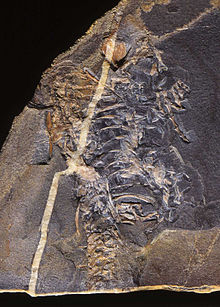Casineria
| Casineria | |
|---|---|

| |
| The counterslab of the holotype fossil | |
| Scientific classification | |
| Domain: | Eukaryota |
| Kingdom: | Animalia |
| Phylum: | Chordata |
| Clade: | Sarcopterygii |
| Clade: | Tetrapodomorpha |
| Clade: | Eotetrapodiformes |
| Clade: | Elpistostegalia |
| Clade: | Stegocephali |
| Genus: | †Casineria Paton, Smithson & Clack, 1999 |
| Type species | |
| †Casineria kiddi Paton, Smithson & Clack, 1999
| |
Casineria is an extinct
Description

Casineria was a small animal with a postcrania length estimated to have been 15 centimeters. Its small size would have made it ideal for hunting the invertebrates of the Carboniferous.[1]
Casineria had five fingers, with the bones at the finger tip being tapering and curved. This spurred the initial describers to argue that it was the oldest known animal with claws on each hand, and marks the earliest clawed foot.[1] Claws are extremely rare among amphibians, but ubiquitous among amniotes, so their supposed presence in Casineria has been considered to be evidence towards its amniote identity. Claws are also a feature intimately bound to the formation of keratinous scales in reptiles, so in life, Casineria would have borne scaly, reptilian-type skin, and would have resembled a small lizard (despite being only distantly related to true lizards).[7]
Under the hypothesis that it was among the first amniotes in the biological sense, it would have laid an amniotic
However, later studies have not consistently placed Casineria as an early amniote.[3][4][6] Even the presence of claws has been considered doubtful, as Marjanovic & Laurin (2019) noted that the finger tips were squared-off, rather than pointed.[5]
Discovery

In 1992, an amateur fossil collector spotted the remnants of this four-legged creature on the shore of Cheese Bay, Scotland.[8] For the next five years, the fossil languished at the National Museum of Scotland in Edinburgh while researchers focused on other projects. Consisting of a slab and counterslab (compression fossil) of a single partial skeleton, the fossil was cataloged with the specimen designation NMS G.1993.54.1. Around 1997, work began to expose the remainder of the fossil from the surrounding matrix. The work revealed that the animal probably lived in an environment much drier than previously understood. The findings were first reported in the April 8, 1999 edition of Nature.[1]
Classification
While retaining a general build like those found in the amphibian reptiliomorph groups like Seymouriamorpha and Diadectomorpha, Casineria also shows features that tie it in with early reptiles, notably a generally gracile build with light leg bones, unfused ankles and toes terminating in claws. This would enable the animal to use their feet actively in traction, rather than as holdfasts, an indication of a primarily terrestrial lifestyle.[1] These traits have been argued to show that it was more closely related to amniotes than to other known reptiliomorph amphibians.
With its advanced features, Casineria may have been one of the first true
See also
References
- ^ S2CID 204992355.
- ^ Monastersky, R. (1999): Out of the Swamps, How early vertebrates established a foothold—with all 10 toes—on land, Science News vol. 155, No. 21, p. 328
- ^ S2CID 129964161.
- ^ S2CID 22421017.
- ^ PMID 30631641.
- ^ a b c Chapter 6: "Walking with early tetrapods: evolution of the postcranial skeleton and the phylogenetic affinities of the Temnospondyli (Vertebrata: Tetrapoda)." In: Kat Pawley (2006). "The postcranial skeleton of temnospondyls (Tetrapoda: temnospondyli)." PhD Thesis. La Trobe University, Melbourne.
- Acta Zoologica: Morphology and Evolution, vol 89 (2): pp 169–178. abstract
- ^ "Archived copy" (PDF). Archived from the original (PDF) on 2008-07-28. Retrieved 2008-03-22.
{{cite web}}: CS1 maint: archived copy as title (link)
Further reading
- Richard Monastersky, "Out of the Swamps: How early vertebrates established a foothold—with all 10 toes—on land" Archived 2012-02-27 at the Wayback Machine, The Weekly Newsmagazine of Science, Volume 155, Number 21 (May 22, 1999)
- The Encyclopedia of Dinosaurs & Prehistoric Creatures/Dougal Dixon
